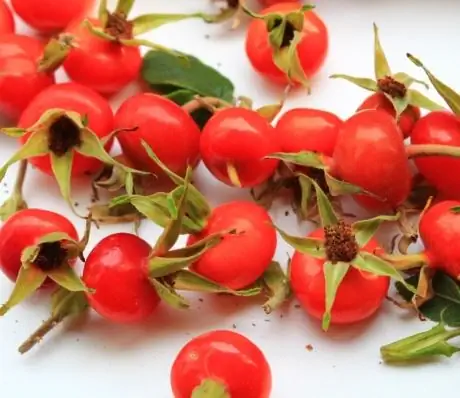- Author Rachel Wainwright [email protected].
- Public 2023-12-15 07:39.
- Last modified 2025-11-02 20:14.
Cherry tomatoes
Cherry tomatoes are known for their small size. Indeed, the mass of one fruit is about 25 - 30 grams, that is, comparable to large berries. These tomatoes got their name from "cherry", which means "cherry" in English.
The ratio of BJU in the product

Source: depositphotos.com How to burn 15 kcal?
| Walking | 4 minutes |
| Jogging | 2 minutes. |
| Swimming | 1 min. |
| A bike | 2 minutes. |
| Aerobics | 3 min. |
| Household chores | 5 minutes. |
For sale in food such tomatoes are grown on an industrial scale in Turkey, Holland, Spain, from where they usually end up on our table.
For the first time cherry tomatoes were bred in 1973, when breeders achieved a slowdown in the ripening of tomatoes in hot conditions. Since then, many varieties have appeared. Different varieties of cherry tomatoes differ in a variety of colors (from shades of red and pink to yellow), shapes (elongated, spherical, teardrop-shaped) and tastes. The taste of these tomatoes can be classic, and there are also dessert sweet varieties of cherry tomatoes, including those with aromas of various berries and fruits - raspberries, blueberries, melons, etc.
The plants of these tomatoes are very decorative, they are even used to decorate personal plots and summer cottages. Cherry tomatoes are either tall or short. They bear fruit well both in open ground and in greenhouses, on a windowsill. Plants can be planted in open ground only after the threat of the last frost has passed. For indoor cultivation, you should choose cherry tomato varieties with an adult bush size up to 40 cm.
Tall tomatoes form clusters up to a meter long. On average, about 18 fruits ripen on one cluster. When unripe, they look like bunches of very large grapes. It is very difficult for such branching plants to grow without support; thin sticks are usually used as support.
Cherry tomatoes absolutely cannot stand a lack of moisture, they need to be watered every day. It is important to harvest on time, as unripe tomatoes will not be sweet enough, and overripe ones usually fall to the ground.
Useful properties of cherry tomatoes
Cherry tomatoes are a source of organic acids, vitamins B, C, E, trace elements - calcium, potassium, iron, phosphorus, etc. The benefits of cherry tomatoes are also in the normalization of metabolism, slowing down the aging of the body.
Cherry tomatoes contain lycopene, an organic substance that gives them their red coloration. Lycopene is a very strong antioxidant, it is able to prevent the appearance of cancer of the esophagus, stomach, intestines, lungs. Cherry tomatoes are especially valuable when consumed in cases of oncological diseases of the female genital organs.
There are observations that cherry tomatoes reduce the incidence of cardiovascular disease. Since lycopene is a fat-soluble substance, it is best to consume them with vegetable oil or sour cream to maximize the benefits of cherry tomatoes. Characteristically, heat treatment does not destroy lycopene in cherry tomatoes.
The calorie content of fresh cherry tomatoes is about 16 kcal per 100 g, in pickled about 18 kcal per 100 g of product. This is not surprising, because up to 90% of their composition is water. Such a low calorie content of cherry tomatoes allows us to classify them as a dietary product that can be recommended for obesity and overweight problems.
Cherry tomatoes are known to improve mood and counteract depression.
Cooking cherry tomatoes
The piquant taste of cherry tomatoes has been appreciated by cuisines of different countries, but the recipes using cherry tomatoes in Italian cuisine are especially varied.
The decorative appearance and excellent taste are the main arguments in favor of eating fresh cherry tomatoes. They are perfect for decorating any dish; they can be used to prepare delicious salads and snacks. Due to their small size, these tomatoes are often added whole, which gives the salads an unusual appearance. It is a good addition to meat dishes, pizza.
Cherry tomatoes can be kept fresh for much longer than regular tomatoes. In addition, they are good in pickled, salted form. For long-term storage, they can even be dried and then added as a dressing for soups and side dishes.

Contraindications to cherry tomatoes
Despite all the benefits of cherry tomatoes, they should be used with caution by people with ulcerative lesions of the gastrointestinal tract and pancreatitis (inflammation of the pancreas). Although cherry fruits contain less organic acids and more sugar than regular tomatoes, they can increase gastric acidity. Usually it is recommended to consume up to 8 - 9 pieces of cherry tomatoes per day.
The use of cherry tomatoes should also be limited to people with significant metabolic disorders, as well as with a predisposition to allergic reactions.
YouTube video related to the article:
Found a mistake in the text? Select it and press Ctrl + Enter.






